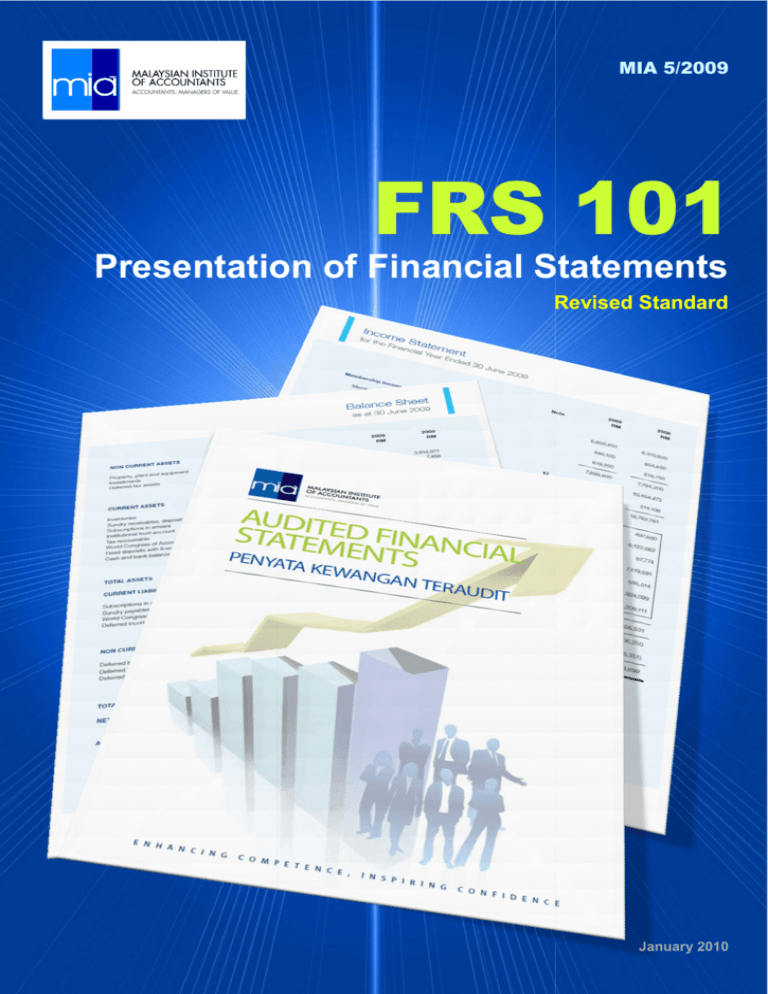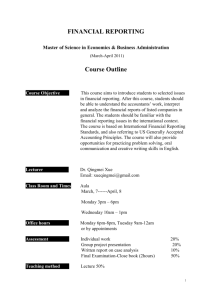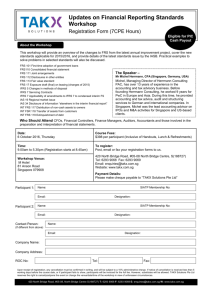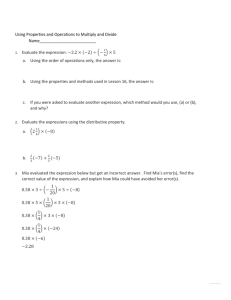
MIA 5/2009
FRS 101
Presentation of Financial Statements
Revised Standard
January 2010
Copyright© January 2010 by the Malaysian Institute of Accountants (MIA). All rights reserved. Permission is granted to make copies of this work provided that such copies are for use in
academic classrooms or for personal use and are not sold or disseminated and provided that each copy bears the following credit line: “Copyright © (Month and Year) by the Malaysian
Institute of Accountants (MIA). All rights reserved. Used with permission of MIA. Contact communications@mia.org.my for permission to reproduce, store or transmit this document.”
Otherwise, written permission from MIA is required to reproduce, store or transmit, or to make other similar uses of, this document, except as permitted by law. Contact
communications@mia.org.my
INTRODUCTION
On 15 September 2009, the Malaysian Accounting Standards Board (“MASB”) issued a revised FRS 101
Presentation of Financial
inancial Statements
Statements, which is effective for annual periods beginning on or after 1 January 2010,
2010
with early application permitted. This revised standard, issued in light of the revisions made by the International
Accounting Standards Board (“IASB”) on IAS 1 Presentation of Financial Statements in 2007 (as amended in 2008
and 2009), supersedes the MASB’s 2005 version of FRS 101 Presentation of Financial Statements (as amended in
2008).
Changes introduced in this revised standard were relatively minor, but tthey
hey represent the first step in IASB’s
comprehensive project on reporting financial information, jointly with the Financial Accounting Standards Board
(“FASB”) of the United States of America.
Prelude to a Revolutionary Change
The joint project between IASB
ASB and FASB to establish a new, joint standard for financial statement presentation
commenced since April 2004. The joint project consists of three phases, as follows:
The completion of Phase A deliberation and all other due processes gave rise to the issuance of a revised IAS 1 on
6 September 2007, bringing IAS 1 largely into line with FASB Statement No. 130 Reporting Comprehensive Income.
Income
Nevertheless, the joint project is still in progress at Phase B, which is likely to bring about future fundamental
fundament
changes in the presentation of financial statements. Phase B, which is not expected to be completed until 2011,
will result in future revisions to FRS 101, as well as FRS 107 Statement of Cash Flows.
1
Main Change – Statement of Comprehensive
Income
The revised FRS 101 introduces the term “total comprehensive income” – defined as changes in equity during a
period, other than those changes resulting from transactions with owners in their capacity as owners. The revised
standard requires such changes in equity to be presented in either of the following manner, separately from
changes in equity arising from transaction with owners in their capacity as owners:
(a)
(b)
In a single statement of comprehensive income (as illustrated in Exhibit A to this publication); or
In two statements (as illustrated in Exhibit B to this publication) comprising:
(i)
a separate income statement, which displays components of profit or loss; and
(ii)
a statement of comprehensive income, which begins with profit or loss and displays components of
other comprehensive income (“OCI”, i.e. items of income and expense that are not recognised in
profit or loss as required or permitted by other FRSs).
The above represents a change from the previous FRS 101 requirements to present an income statement, and:
(i)
a statement of changes in equity – showing either all changes in equity; or
(ii)
a statement of recognised income and expenses – showing changes in equity other than those arising from
transactions with equity holders acting in their capacity as equity holders.
Hence, the revised FRS 101 now requires all income and expenses, whether recognised in the profit or loss or
otherwise, to be presented in the statement of comprehensive income. Presentation of non-owner changes in
equity in the statement of changes in equity or statement of recognised income and expenses is now prohibited.
The purpose of this change is to provide better information to users by requiring aggregation of items with shared
characteristics.
2
Existing FRS 101
(2005 version)
Revised FRS 101
(2009 version)
Income Statement
Income Statement
Statement of Recognised
Income and Expenses
Changes in equity –
transaction with equity holders
acting in their capacity as
equity holders
Other comprehensive
income (“OCI”)
Statement of Changes
in Equity
Statement of
Comprehensive
Income
Statement of Changes
in Equity
In a nutshell, this change is illustrated as follows:
OCI may include the following components:
•
changes in revaluation surplus arising from
subsequent measurement of property, plant
and equipment or intangible assets based on
the revaluation model;
•
actuarial gains and losses on defined benefit
plans
recognised
in
accordance
with
Paragraph 93A of FRS 119 Employee Benefits;
•
gains and losses arising from translating the
financial statements of a foreign operations;
•
gains and losses on remeasuring available-forsale financial assets; and
•
the effective portion of gains and losses on
hedging instruments in a cash flow hedge.
Reclassification Adjustments
Reclassification
adjustments
are
amounts
reclassified to profit or loss in the current period that
were recognised in OCI in the current or previous
Entities may present components of OCI on the
period, as required by other FRSs. They arise, for
statement of comprehensive income either net of
example, on derecognition of an available-for-sale
related tax effect or before related tax effect. The
financial asset and on disposal of a foreign
components of OCI as illustrated in Exhibits A and B
operations.
are presented on pre-tax basis.
The
revised
FRS
101
requires
reclassification
Regardless
of
whether
a
pre-tax
or
post-tax
adjustments relating to components of OCI to be
presentation is used, disclosure of the amount of
disclosed. Nevertheless, entities may choose to
income tax expense/benefit allocated separately to
present
individual components of OCI is required in the
reclassification
adjustments
in
the
statement of comprehensive income or in the
notes.
notes to the financial statements. Entities presenting
reclassification adjustments in the notes to the
financial statements present the components of
OCI in the statement of comprehensive income
after any related reclassification adjustments.
OCI and Income Tax
Further to that, the revised FRS 101 requires the
disclosure
of
income
component
of
adjustments.
This
OCI,
tax
relating
including
disclosure
is
to
each
reclassification
deemed
useful
because components of OCI often have different
tax rates as opposed to tax rate(s) applied to profit
or loss.
3
Statement of Changes
in Equity
Equity
As discussed earlier, entities no longer have the option of
presenting non-owner
owner movements as separate items in
the statement of changes in equity.
More importantly, transactions with owners in their
capacity as owners shall now be presented in the
statement of changes in equity and can no longer be
provided in the notes to the financial statements, as was
previously the case. For entities that have presented a
separate statement of recognised income and expenses
in prior years, the financial statements
nts shall now include a
statement of changes in equity that present information
that has previously been presented in the notes.
In addition, the amount dividends recognised as
distributions to owners during the period and the
related amount per share shallll now be disclosed
either in the statement of changes in equity or in
the notes to the
financial statements and can no longer be
presented
on
the
face
of the
statement.
The statement of changes in equity is
as illustrated in Exhibit C to this
publication.
4
income
“
Transactions with
owners in their capacity
as owners shall now be
presented in the
statement of changes in
equity and can no longer
be provided in the notes
to the financial
statements, as was
previously the case.
case
”
New Titles for the
Statements
Statement of Financial Position
The revised FRS 101 introduced new titles to some
Statement of Comprehensive Income
of the statements contained in a complete set of
Statement of Cash Flows
Income Statement
financial statements.
A “balance sheet” is now referred to as a
“statement of financial position”, whereas a “cash
flow statement” is referred to as a “statement of
cash flows”.
Where an entity elects to present income and
expenses
using
a
single
statement
of
comprehensive income, that statement is referred
to as a “statement of comprehensive income”.
Otherwise (where the two-statement approach is
elected),
the
comprehensive
statement
income
is
presenting
referred
to
other
as
Comparatives
The
disclose
comparative
unchanged from the requirement in the previous FRS
101, other than in the following circumstances:
(a)
Retrospective
application
of
accounting
policy;
(b)
“statement of recognised income and expense”,
as how it was referred to in the previous FRS 101).
to
information provided in the revised FRS 101 remains
a
“statement of comprehensive income” (and not
requirements
Retrospective restatement of items in the
financial statements; or
(c)
Reclassification
of
items
in
the
financial
statements.
It is interesting to note that, although the new titles
will be used in all FRSs from the effective date of the
revised FRS 101, they are not mandatory for use in
the financial statements.
In the interests of comparability and simplicity,
In those limited circumstances, entities shall, as a
minimum, present three (3) statements of financial
position as at:
(a)
the end of the current period;
(b)
the end of the previous period (which is the
nonetheless, we would recommend the new titles
same as the beginning of the current period);
to be used in the financial statements upon the
adoption of the revised FRS 101.
and
(c)
the beginning of the earliest comparative
period.
This new requirement is not expected to bring about
significant challenge to entities, as the opening
financial position amounts would have to be
recalculated
in
any
case.
Perhaps,
the
new
requirement simply presents a challenge from a
word-processing perspective.
5
New Disclosures on Financial Instruments
The revised FRS 101 incorporates new disclosure requirements relating to financial instruments as a consequence
from other FRSs, covering the following areas:
(a)
Capital disclosure; and
(b)
Financial instrument puttable at fair value and obligations arising on liquidation
The new disclosure requirements are further elaborated as follows:
Capital disclosure
In August 2005, IASB issued an amendment to IAS 1 on capital disclosures to complement the issuance of IFRS 7
Financial Instruments: Disclosure. This amendment introduces requirements for disclosures about an entity’s
capital, and it is aimed to provide better information for users of financial statements to make informed
judgments about risk and return.
As a complementary amendment, the requirement is incorporated into the revised FRS 101 to co-terminus with
the effective date of FRS 7 Financial Instruments: Disclosures in Malaysia, i.e. 1 January 2010.
In light of this addition to the revised FRS 101, entities are required to disclose information relating to the
management of capital, which include the following:
•
Qualitative information about the entity’s
objectives,
policies
and
processes
for
managing capital, including:
o
description of capital it manages;
o
nature of external capital requirements, if
any; and
o
how
is
it
meeting
its
objectives
in
managing capital.
•
Quantitative data about what the entity
regards as capital.
•
Changes in the above qualitative information
and quantitative data from one period to
another.
•
Whether the entity has complied with any external capital requirements, and, if not complied, the
consequences of such non-compliance.
6
Financial instrument puttable at fair value and obligations arising
on liquidation
On 15 September 2009, MASB amended FRS 132
Financial Instruments: Presentation with respect to the
classification of puttable financial instruments and
obligations arising only on liquidation. As a result, some
financial instruments that previously meet the definition
of a financial liability will be reclassified as equity
because they represent the residual interest in the net
assets of an entity. This amendment is effective from
annual periods beginning on or after 1 January 2010.
This amendment to FRS 132 resulted in the inclusion of
new disclosure requirements in the revised FRS 101
relating to puttable financial instruments classified as
equity.
The revised FRS 101 requires the following additional
disclosures if an entity has a puttable instrument that is
classified as equity instrument:
•
Summary quantitative data about the amount
•
The entity’s objectives, policies and processes for
classified as equity.
managing its obligation to repurchase or redeem
the instruments when required to do so by the
instrument holders, including any changes from the
previous period.
•
The expected cash outflow on redemption or
•
Information about how the expected cash outflow
repurchase of that class of financial instruments.
on redemption or repurchase was determined.
7
Next Step
Phase B of the joint project between IASB
and
FASB
on
presentation,
financial
statement
focusing
fundamental
on
questions
more
about
presentation of information in financial
statements,
is
currently
in
progress.
Among others, Phase B of the joint
project seeks to address the following
concerns and criticisms:
•
Limited presentation guidance in the
present
framework,
allowing
financial statements be presented in
many alternate ways;
•
Transactions or events recognised in the financial statements are not presented consistently in each of the
individual statements; and
•
Information is not sufficiently disaggregated.
The Boards have since published their preliminary views on these fundamental issues in the form of a Discussion
Paper in October 2008 with the following key proposals:
•
Classification of items in the financial statements into business, financing, equity, discontinued operations
and income tax sections, based on management approach, and the classification is to be applied
consistently to the items in the statements of financial position, comprehensive income and cash flows;
•
A single statement of comprehensive income is to be presented, comprising the usual income statement
items and “other comprehensive income” items, i.e. other non-owner changes in equity (eliminating the
option to present comprehensive income in two statements);
•
Cash flows from operating activities in the statement of cash flows are to be presented using the direct
method, eliminating the ability to use the indirect method.
•
Introducing a new disclosure requirement to reconcile cash flows to comprehensive income.
IASB expects to issue an Exposure Draft in the second quarter of 2010 and, the final standard by 2011. As
Malaysia is moving towards full convergence with the International Financial Reporting Standards (“IFRS”) by 1
January 2012, it is likely that the proposed final standards will be made effective simultaneously in Malaysia and
other IFRS jurisdictions.
8
Exhibit A
Comprehensive Income – Single Statement
Kindly be informed that the illustrations are condensed in order to focus attention on the changes
resulting from the revised FRS 101. They do not present all the items required to be presented on the face
of the financial statements by FRS 101 and other FRSs.
XYZ Sdn Bhd
Statement of Comprehensive Income for the financial year ended 31 December 2010
2010
RM
Revenue
Expenses
Profit before tax
Income tax expense
2009
RM
400,000
500,000
(200,000)
(250,000)
200,000
250,000
(52,000)
(67,500)
Profit for the year from continuing operations
148,000
182,500
Loss for the year from discontinued operations
(30,000)
-
Profit for the year
118,000
182,500
3,000
5,000
2,500
4,000
1,200
500
4,000
2,000
Other comprehensive income1
Exchange differences on translating foreign operations
Available-for-sale financial assets
Cash flow hedges
Gains on property revaluation
Actuarial (losses)/gains on defined benefits pensions plans
Income tax relating to components of other comprehensive income
(650)
1,500
(2,613)
(3,510)
Other comprehensive income for the year, net of tax
7,437
9,490
125,437
191,990
94,400
146,000
23,600
36,500
118,000
182,500
100,350
153,592
25,087
38,398
125,437
191,990
Total comprehensive income for the year
Profit attributable to:
Owners of the parent
Minority interest
Total comprehensive income attributable to:
Owners of the parent
Minority interest
1
Each component of OCI illustrated here is presented before related tax effect. Alternatively, the components of OCI could be
presented net of related tax effect.
9
Exhibit B
Comprehensive Income – Two Statements
Kindly be informed that the illustrations are condensed in order to focus attention on the changes
resulting from the revised FRS 101. They do not present all the items required to be presented on the face
of the financial statements by FRS 101 and other FRSs.
Under the two-statement approach, the income statement is required to be presented immediately
before the statement of comprehensive income.
XYZ Sdn Bhd
Income Statement for the financial year ended 31 December 2010
Revenue
Expenses
Profit before tax
Income tax expense
2009
RM
400,000
500,000
(200,000)
(250,000)
200,000
250,000
(52,000)
(67,500)
Profit for the year from continuing operations
148,000
182,500
Loss for the year from discontinued operations
(30,000)
-
Profit for the year
118,000
182,500
94,400
146,000
Profit attributable to:
Owners of the parent
Minority interest
10
2010
RM
23,600
36,500
118,000
182,500
Exhibit B (Continued)
Comprehensive Income – Two Statements
XYZ Sdn Bhd
Statement of Comprehensive Income for the financial year ended 31 December 2010
Profit for the year
Other comprehensive income1
Exchange differences on translating foreign operations
Available-for-sale financial assets
Cash flow hedges
Gains on property revaluation
Actuarial (losses)/gains on defined benefits pensions plans
Income tax relating to components of other comprehensive income
Other comprehensive income for the year, net of tax
2010
RM
2009
2009
RM
118,000
182,500
3,000
5,000
2,500
4,000
1,200
500
4,000
2,000
(650)
1,500
(2,613)
(3,510)
7,437
9,490
Total comprehensive income for the year
125,437
191,990
Total comprehensive income attributable to:
Owners of the parent
Minority interest
100,350
153,592
25,087
38,398
125,437
191,990
1
Each component of OCI illustrated here is presented before related tax effect. Alternatively, the components of OCI could be
presented net of related tax effect.
11
Exhibit C
Statement of Changes in Equity
XYZ Sdn Bhd
Statement of changes in equity
Share
Capital
Balance at 1 January 2009
Changes in accounting policy
Restated balance
Retained
Earnings
Translation
of Foreign
Operations
Availablefor-sale
financial
assets
Cash Flow
Hedges
Revaluation
Surplus
Total
Minority
Interest
Total Equity
250,000
132,000
(3,200)
2,000
9,600
-
390,400
100,000
490,400
-
1,000
-
-
-
-
1,000
-
1,000
250,000
133,000
(3,200)
2,000
9,600
-
391,400
100,000
491,400
-
-
-
-
(21,000)
-
(21,000)
1,168**
153,592
38,398
191,990
Changes in equity for 2009
Dividends
-
(21,000)
Total comprehensive income for
the year
-
146,876*
2,920**
Balance at 31 December 2009
250,000
258,876
(280)
4,336
9,892
1,168
523,992
138,398
662,390
-
-
-
-
(10,000)
-
(10,000)
2,368**
100,350
25,087
125,437
3,536
614,342
163,485
777,827
2,336**
292**
Changes in equity for 2010
Dividends
-
(10,000)
Total comprehensive income for
the year
-
94,015*
Balance at 31 December 2010
250,000
342,891
1,776**
1,480**
1,496
5,816
711**
10,603
*
Profit for the year attributable to owners of the parent plus actu
actuarial
arial gains/losses on defined benefits pension plans. Amount included in retained earnings for 2009 represents profit attributable
attribu
to
owners of the parent of RM146,000 plus actuarial gains on defined benefits pension plans of RM876 (RM1,500, less tax RM405
RM405, less non-controlling
controlling interests RM219). Amount included in retained earnings
for 2010 represents profit attributable to owners of the parent of RM94,400 plus actuarial losses on defined benefits pension plans of RM385 (RM650, less tax RM169, less non-controlling
non
interests RM96)
**
The amount included in the translation of foreign operations, available
available-for-sale
sale financial assets, cash flow hedges and revaluation surplus represent other comprehensive income for each component,
net of tax and minority interest.
The Malaysian Institute Of Accountants (“MIA”)
MIA is a statutory body established under the Accountants Act, 1967 to regulate and develop
the accountancy profession in Malaysia. To date, MIA has close to 25,000 members. For more
information please visit: www.mia.org.my
The Use of the Word “Accountant”
In Malaysia, the word “accountant” is protected as provided for under the provisions of the Act
which states that no one can hold himself out or practise as an accountant unless he is
registered as a member of MIA.
DISCLAIMER STATEMENT
Disclaimer
1. This document contains general information only and MIA is not, by means of this
document, rendering any professional advice or services. This document is not a substitute
for such professional advice or services, nor should it be used as a basis for any decision or
action that may affect your business. Before making any decision or taking any action that
may affect your business, you should consult a professional advisor.
2. Whilst every care has been taken in compiling this document, MIA makes no representations
or warranty (expressed or implied) about the accuracy, suitability, reliability or completeness
of the information for any purpose.
3. MIA, its employees or agents accept no liability to any party for any loss, damage or costs
howsoever arising, whether directly or indirectly from any action or decision taken (or not
taken) as a result of any person relying on or otherwise using this document or arising from
any omission from it.
Dewan Akauntan
No. 2, Jalan Tun Sambanthan 3
Brickfields, 50470 Kuala Lumpur
Malaysia
[phone] +603 2279 9200
[fax] +603 2274 1316
[web] www.mia.org.my
[email] technical@mia.org.my
cal@mia.org.my








